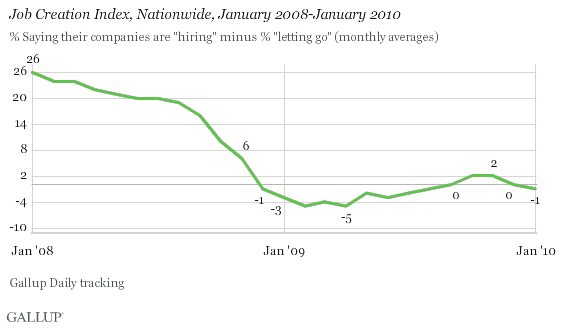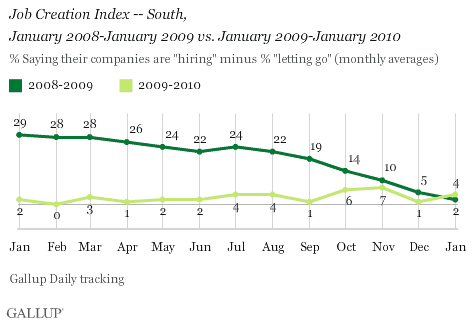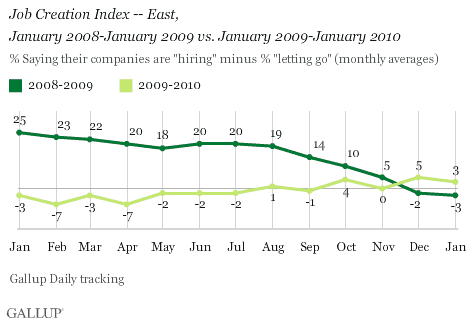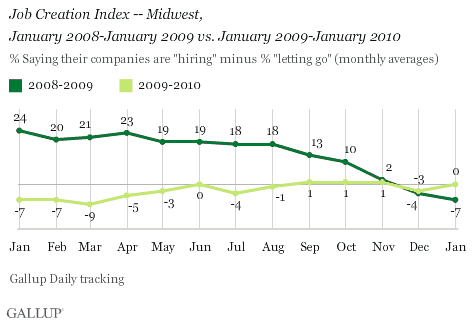PRINCETON, NJ -- Gallup's Job Creation Index -- based on U.S. employees' self-reports of hiring and firing activity at their workplaces -- shows that perceptions of current job-market conditions nationwide worsened slightly in January compared to December. Job-market conditions are best in the South and the East, improving in the Midwest, but deteriorating in the West.

Gallup's Job Creation Index -- based on interviews with 17,145 U.S. workers in January -- dipped to -1 in January after being at 0 or +2 in each of the prior four months. The Index fell slightly in January owing to a decline in the percentage of companies hiring to 23% (from December's 24%), while the percentage letting go remained at 24%. Still, this January's job-market conditions are better than those of a year ago, when the hiring and letting-go numbers were 23% and 26%, respectively. While layoffs have declined from their elevated levels of the first half of 2009, hiring is no better now than it was last January.

South: Best and Improving
In January, the South returned to its familiar position of having the best jobs picture of any region. Gallup's Job Creation Index in the South improved to +4 in January from +1 in December -- the highest Index score of any region, suggesting the best job-market conditions nationwide. The percentage of workers saying their employers were hiring new employees and expanding their workforces improved to 26% in January from 25% in December, while the percentage saying their employers were letting people go declined to 22% from 24%. As anticipated, January's improvement probably reflects, at least in part, the surge in oil prices late last year -- and their higher level compared to a year ago.

East: Job Conditions Decline but Remain Above Average
Job-market conditions in the East deteriorated in January to +3 from December's +5. The percentage of employers who are hiring fell slightly to 25%, compared to 26% in December. On the other hand, 22% said their companies are letting people go -- also a slight deterioration from December's 21%. Despite the slight decline in January, Gallup's Job Creation Index shows job conditions in the East second only to those in the South. The sharp gains on Wall Street and improving condition of the nation's largest financial firms seem to have led to a substantially improved job market in this part of the country.

Midwest: Job Loss Improves, Hiring Unchanged
Midwestern job-market conditions improved in January, returning to the trend of the prior three months. Gallup's Job Creation Index improved to 0 from -3 in December -- close to the +1 of September through November. The improvement reflects a decline in the percentage of companies letting people go, from 25% in December to 22% in January, while the percentage hiring remained at 22%. Midwest job-market conditions may reflect the continued improvement in manufacturing, particularly in the auto industry, that has taken place over the past several months.

West: Continuing to Deteriorate
Job-market conditions in the West worsened to -9 during January, down considerably from -2 in December. Only 20% of employees say their companies are hiring -- down from 22% the prior month -- while 29% say their companies are letting employees go, a deterioration of five points from 24% in December. Job-market conditions in the West continue to suffer from weak housing markets in many parts of the region.

Commentary
Right now, the financial and equity markets are focused on Friday's jobs report. Wednesday's ADP report showed private-sector companies letting go of an estimated 22,000 employees -- the smallest decline in two years. On the other hand, the Challenger, Gray, and Christmas report showed planned layoffs increasing to 71,482 in January from December's two-year low of 45,094. Adding to the murky view, the Institute of Supply Management's services index expanded less than expected last month.
Further, seasonal adjustments will influence the government's unemployment rate; those adjustments will in turn be affected by last year's sharp jobs declines and the hiring of three-quarters of a million new census takers.
Gallup's modeling -- based on its Job Creation Index -- suggests the government will report that the unemployment rate increased to 10.1% or more in January.
Regardless of the actual numbers in January's unemployment report, Gallup's continuous monitoring of employees' perceptions of the jobs market suggests that there has been virtually no improvement in job creation during recent months or, for that matter, from a year ago. A reduction in layoffs is a positive for the job market but is far from what is needed to bring the unemployment rate down and to get consumers spending.
On Feb. 23, 2010, at its world headquarters in Washington, D.C., Gallup for the first time will release the findings from its daily U.S. employment tracking, including insights into the U.S. workforce's state of mind. Learn more ...
Survey Methods
For Gallup Daily tracking, Gallup interviews approximately 1,000 national adults, aged 18 and older, each day. The Gallup consumer spending results are based on random half-samples of approximately 1,000 national adults, aged 18 and older, each day. The Gallup Job Creation Index results are based on a random sample of approximately 500 current full- and part-time employees each day.
Regional results for January are based on Gallup Daily tracking interviews totaling more than 3,000 in each region. For each total regional sample, one can say with 95% confidence that the maximum margin of sampling error is ±3 percentage points.
Interviews are conducted with respondents on land-line telephones and cellular phones.
In addition to sampling error, question wording and practical difficulties in conducting surveys can introduce error or bias into the findings of public opinion polls.
